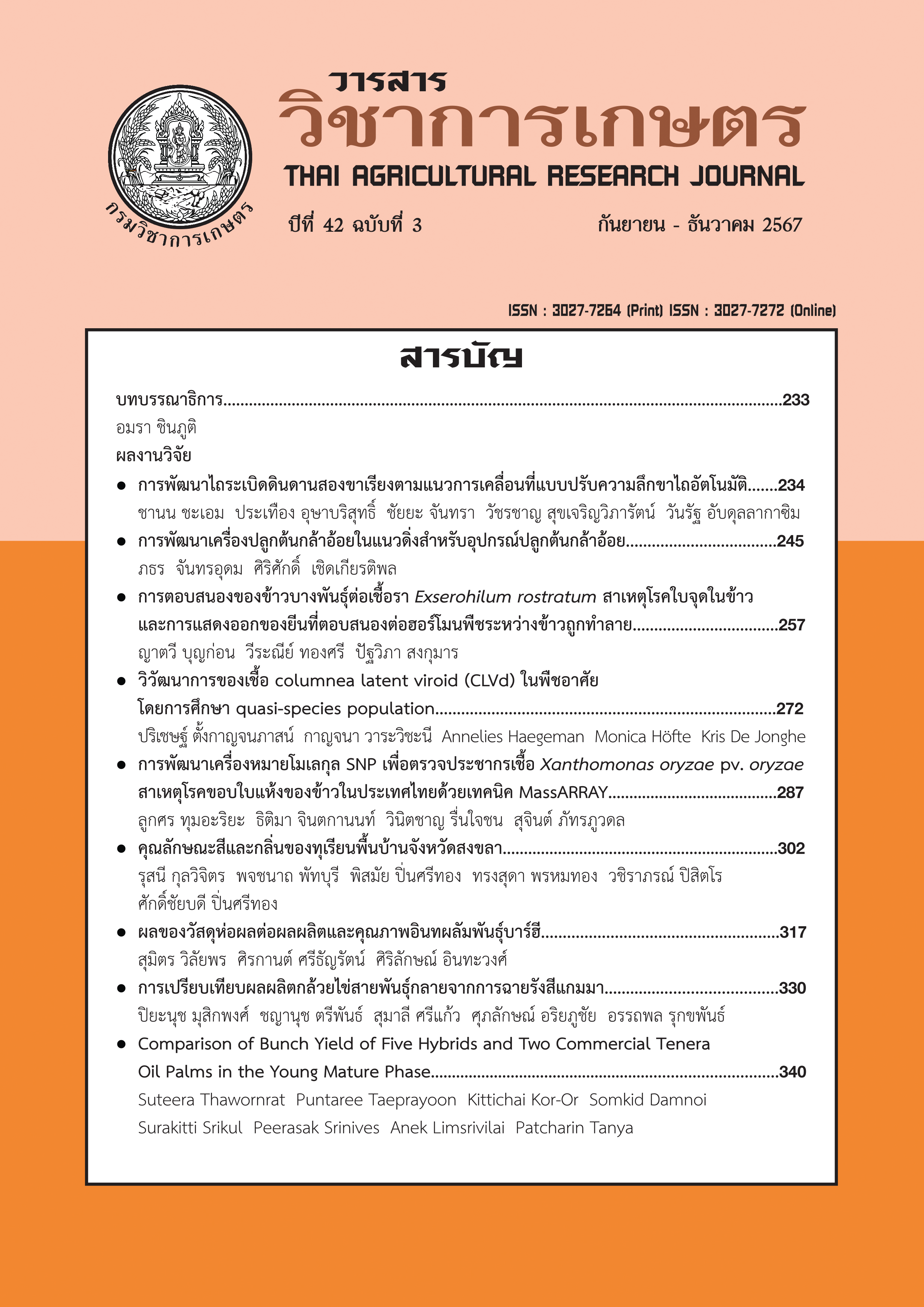คุณลักษณะสีและกลิ่นของทุเรียนพื้นบ้านจังหวัดสงขลา
DOI:
https://doi.org/10.14456/thaidoa-agres.2024.24คำสำคัญ:
กลิ่น, ทุเรียนพื้นบ้าน, สงขลา, องค์ประกอบทางเคมี, แก๊สโครมาโทกราฟ-แมสสเปกโทรมิเตอร์บทคัดย่อ
ข้อมูลด้านสีและกลิ่นของทุเรียนพื้นบ้านในประเทศไทยมีค่อนข้างน้อย งานวิจัยนี้มีวัตถุประสงค์เพื่อศึกษาลักษณะทางกายภาพและเคมีของกลุ่มทุเรียนพื้นบ้านของจังหวัดสงขลา 7 พันธุ์ ได้แก่ พันธุ์สุปนาแสน พิกุลกลิ่น ไอ้เหลือง เล็บเหยี่ยว มุกตาอ่ำ นมสาว และนมสด ด้วยเครื่องมือวิทยาศาสตร์ เพื่อเก็บเป็นฐานข้อมูลในการส่งเสริมและคัดเลือกพันธุ์ในอนาคต โดยนำเนื้อทุเรียนพื้นบ้านทั้ง 7 พันธุ์มาตรวจวัดค่าสีด้วยเครื่องวัดสี ตรวจองค์ประกอบธาตุอินทรีย์ด้วยเครื่องวิเคราะห์ CHNS/O และตรวจชนิดสารอินทรีย์ให้กลิ่นโดยการสกัดด้วยเทคนิค HS-SPME แล้วตรวจวัดด้วยเครื่อง GC-MS ผลการตรวจวิเคราะห์ พบว่า ค่าดัชนีความเหลืองสามารถบอกความแตกต่างของทุเรียนแต่ละพันธุ์ในเบื้องต้นได้ดีและรวดเร็ว ปริมาณร้อยละโดยน้ำหนักของธาตุ พบว่า พันธุ์สุปนาแสนมีธาตุคาร์บอนและไฮโดรเจนสูงสุด 44.42±0.20 และ 7.04±0.04% ตามลำดับ พันธุ์นมสาวมีปริมาณไนโตรเจน และซัลเฟอร์สูงสุด 1.49±0.02 และ 0.11±0.01% ตามลำดับ พันธุ์ไอ้เหลืองมีปริมาณออกซิเจนสูงสุด 48.12±0.22% ส่วนชนิดสารอินทรีย์ระเหยง่ายซึ่งแสดงลักษณะกลิ่น พบว่า มีความแตกต่างกันตามพันธุ์ทุเรียนระหว่าง 52-74 ชนิด จำแนกได้ 18 หมู่ฟังก์ชัน โดยสารอินทรีย์ระเหยง่ายบางหมู่ฟังก์ชันจำเพาะกับทุเรียนบางพันธุ์เท่านั้น ได้แก่ แอลดีไฮด์พบเฉพาะพันธุ์ไอ้เหลือง แอซีนพบเฉพาะพันธุ์มุกตาอ่ำ ไดอีนพบในพันธุ์สุปนาแสน และพันธุ์เล็บเหยี่ยว อีเทอร์พบในพันธุ์นมสาว และพันธุ์นมสด ออกซาโซลพบในพันธุ์มุกตาอ่ำ และพันธุ์นมสาว ไทอะโซลพบในพันธุ์ไอ้เหลือง และพันธุ์เล็บเหยี่ยว พบไพราซีนแต่ไม่พบกำมะถันในพันธุ์พิกุลกลิ่น กรดคาร์บอกซิลิกไม่พบในพันธุ์เล็บเหยี่ยว และเทอร์ปีนไม่พบในพันธุ์สุปนาแสน และพันธุ์นมสาว โดยเอสเตอร์และซัลไฟด์เป็นหมู่ฟังก์ชันหลักที่ให้กลิ่นในทุเรียนทุกพันธุ์แต่มีปริมาณแตกต่างกัน ข้อมูลที่ได้สามารถนำไปใช้ประโยชน์ในส่งเสริมและคัดเลือกพันธุ์ทุเรียนพื้นบ้านที่มีสีและกลิ่นเป็นที่ชื่นชอบของผู้บริโภคต่อไป
References
จรัสศรี นวลศรี กรกช นาคคนอง อมรรัตน์ จันทนาอรพินท์ รวีย์รัชต์ รักขันธุ์ และสุภาณี ชนะวีรวรรณ. 2560. การศึกษาความหลากหลายทางพันธุกรรมและคัดเลือกพันธุ์ทุเรียนพื้นบ้านในเขตภาคใต้ของประเทศไทย. หน้า 1-146. ใน: รายงานโครงการวิจัยฉบับสมบูรณ์ 2560. คณะทรัพยากรธรรมชาติ มหาวิทยาลัยสงขลานครินทร์ วิทยาเขตหาดใหญ่.
นิรนาม. 2566. "ไอ้เหลือง" แชมป์เวที 5 ประกวด "เรียนบ้าน" สงขลา. สงขลาโฟกัส. แหล่งข้อมูล: https://สงขลาโฟกัส.com/news/6425/กองฯเกษตรอบจ-สงขลารุก/. สืบค้น: 10 ตุลาคม 2566.
Aschariyaphotha, W., C. Wongs-Aree, K. Bodhipadma and S. Noichinda. 2021. Fruit volatile fingerprints characterized among four commercial cultivars of Thai durian (Durio zibethinus). Journal of Food Quality. 2021(1): 1-12.
ASTM. 2021. Standard test methods for determination of carbon, hydrogen and nitrogen in analysis samples of coal and carbon in analysis samples of coal and coke. American Society for Testing and Materials. 1-11.
Chairat, R., S. Lertsiri and K. Tananuwong. 2022. Volatile compound production and quality characteristics of durian fruit cv. monthong as affected by 1-methylcyclopropene and modified atmosphere storage. International Journal of Fruit Science. 22(1): 481-494.
Charoensumran, P., K. Pratumyot, T. Vilaivan and T. Praneenararat. 2021. Investigation of key chemical species from durian peduncles and their correlations with durian maturity. Scientific Reports. 11(1): 1-9.
Chin, S.T., N. Hamid, S.Y. Quek, Y.B. Man, R.A. Rahman and D. Hashim. 2007. Analysis of volatile compounds from Malaysian durians (Durio zibethinus) using headspace SPME coupled to fast GC-MS. Journal of Food Composition and Analysis. 20: 31-44.
Cullere, L., A. Escudero, J. Cacho and V. Ferreira. 2004. Gas chromatography-olfactometry and chemical quantitative study of the aroma of six premium quality spanish aged red wines. Journal of Agricultural and Food Chemistry. 52: 1653-1660.
De-la-fuente-blanco, A. and V. Ferreira. 2020. Gas chromatography olfactometry (GC-O) for the (Semi) quantitative screening of wine aroma. Foods. 9(12): 1-20.
Firdaus, A., M.A. Samah and K.B. Hamid. 2018. CHNS analysis towards food waste in composting. Journal CleanWAS. 2(1): 6-10.
Genva, M., T.K. Kemene, M. Deleu, L. Lins and M.L. Fauconnier. 2019. Is it possible to predict the odor of a molecule on the basis of its structure?. International Journal of Molecular Sciences. 20(12): 1-16.
Khaksar, G., S. Kasemcholathan and S. Sirikantaramas.2024. Durian (Durio zibethinus L.): Nutritional composition, pharmacological implications, value-added products, and omics-based investigations. Horticulturae. 10(4): 1-23.
Li, J.X., P. Schieberle and M. Steinhaus. 2012. Characterization of the major odor-active compounds in Thai durian (Durio zibethinus L. 'Monthong') by aroma extract dilution analysis and headspace gas chromatography-olfactometry. Journal of Agricultural and Food Chemistry. 60(45): 11253-11262.
Li, J.-X., P. Schieberle and M. Steinhaus. 2017. Insights into the key compounds of durian (Durio zibethinus L. ‘Monthong’) pulp odor by odorant quantitation and aroma simulation experiments. Journal of Agricultural and Food Chemistry. 65(3): 639-647.
Lu, L., Z. Hu, C. Fang and X. Hu. 2023. Characteristic flavor compounds and functional components of fragrant rice with different flavor types. Foods. 12(11): 2185 - 2195.
Martin, A. 2015. 4.4 Lab colour space and delta E measurements. Available at: https://opentextbc.ca/graphicdesign/chapter/4-4-lab-colour-space-and-delta-e-measurements. Accessed: February 18, 2024.
Osman, C.P., N. Kasim, N.S. Salim and N. Aziz. 2022. Discrimination of 11 Malaysian durian cultivars based on sulfur-containing volatiles and esters using multivariate data analysis. Natural Product Communications. 17(1): 1-8.
Oyinloye, T.M. and W.B. Yoon. 2020. Effect of freeze-drying on quality and grinding process of food produce: A review. Processes. 8(3): 1-23.
Radchanui, C. and P. Keawvongsri. 2017. Pattern and production of durian in saikhao community, kokpho district, pattani province. International Journal of Agricultural Technology. 16(6): 791-812.
Sommer, S., L.M. Lang, L. Drummond, M. Buchhaupt, M.A. Fraatz and H. Zorn. 2022. Odor characteristics of novel non-canonical terpenes. Molecules. 27(12): 1-15.
Soo, J. 2019. Volatile esters and sulfur compounds in durians and a suggested approach to enhancing economic value of durians. Malaysian Journal of Sustainable Agriculture. 3: 5-15.
Stein, S.E. 2014. NIST Standard Reference Database 1A. The NIST mass spectrometry data center. 76 p.
Sujang, G.B., S.D. Ramaiya, N. Saupi and S.Y. Lee. 2023. Profiling of volatile organic compounds (VOCs) of wild edible durians from sarawak, borneo associated with its aroma properties. Horticulturae. 9(2): 1-17.
Tao, N.-P., R. Wu, P.-G. Zhou, S.-Q. Gu and W. Wu. 2014. Characterization of odor-active compounds in cooked meat of farmed obscure puffer (Takifugu obscurus) using gas chromatography–mass spectrometry–olfactometry. Journal of Food and Drug Analysis. 22(4): 431-438.
Tifani, K.T., L.P.E. Nugroho and N. Purwanti. 2018. Physicochemical and sensorial properties of durian jam prepared from fresh and frozen pulp of various durian cultivars. International Food Research Journal. 25: 826-834.
Toledo, M. 2023. CHNSO elemental analysis – sample preparation. Available at: https://www.mt.com/in/en/home/applications/Laboratory_weighing/chnso_elemental_analysis.html#overviewaf. Accessed: October 10, 2023.
Wisutiamonkul, A., C. Ampomah-Dwamena, A.C. Allan and S. Ketsa. 2017. Carotenoid accumulation and gene expression during durian (Durio zibethinus) fruit growth and ripening. Scientia Horticulturae. 220: 233-242.
Wisuwat, S., A. Pichakum, P. Traiperm, E. Rungjangsuwan, U. Siriwattanakul, N. Leeratsuwan, P. P. Chareonsap, K. Kulpradit, S. Somsri and S.C. Swangpol. 2019. Diversity of durian (Durio zibethinus L.) from Nonthaburi, Thailand based on morpho-palatability characteristics and simple sequence repeat markers. Agriculture and Natural Resources. 53(3): 218-227.
Zhou, X., H. Wu, J. Pan, H. Chen, B. Jin, Z. Yan, L. Xie and K. Rogers. 2021. Geographical traceability of south-east Asian durian: A chemometric study using stable isotopes and elemental compositions. Journal of Food Composition and Analysis. 101: 1-8.
Downloads
เผยแพร่แล้ว
How to Cite
ฉบับ
บท
License
Copyright (c) 2024 วารสารวิชาการเกษตร

This work is licensed under a Creative Commons Attribution-NonCommercial-NoDerivatives 4.0 International License.
วารสารวิชาการเกษตร


